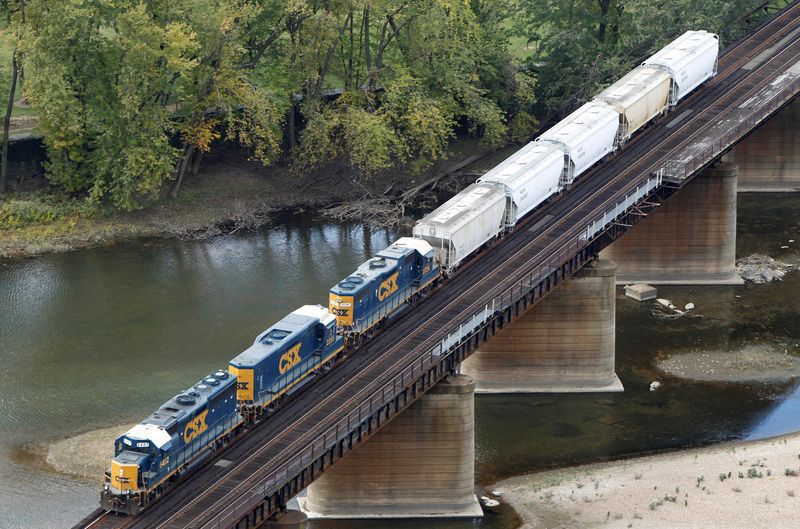By Lisa Baertlein
LOS ANGELES (Reuters) - U.S. shoppers can easily track Amazon (NASDAQ:AMZN) packages to their front door, but big railroad customers can't see the real-time location of shipments of BMW (ETR:BMWG) luxury cars, fuel or fertilizer as they crisscross the country. A U.S. coalition of railroad executives and their customers are working to change that.
The project, called RailPulse, comes as the $99-billion U.S. freight railroad industry seeks to bolster volume that has been stagnant for more than a decade and as customers demand better service. It is establishing standards and building a unified railcar GPS tracking system. The effort, which relies on collaboration between partners whose interests do not always converge, promises to improve planning and ultimately service and efficiency, participants said.
Alan Shaw, CEO of railroad Norfolk Southern (NYSE:NSC), said the 200-year-old U.S. freight rail industry has been slow to adopt certain cutting-edge technology. As a result, it can't tell a carmaker like BMW the exact location of a load of sedans as they move through the system.
E-commerce giant Amazon, meanwhile, has helped set a standard for transportation companies. Railroads need to keep pace, RailPulse founder Mike McClellan said.
"We want more people to feel more comfortable picking rail - particularly this new generation of transportation managers who are ... used to seeing things in real time," said McClellan, who is also Norfolk Southern's chief strategy officer.
RailPulse envisions a revenue model where users pay a one-time charge to equip railcars with tracking technology, periodic fees for communications services and software updates and a monthly subscription fee of $3.50 per car.
It aims to sign up all six major U.S. freight railroads and is halfway there with Norfolk Southern, Union Pacific (NYSE:UNP) and Canadian Pacific (NYSE:CP) Kansas City onboard.
It is also recruiting the nation's 600 "short-line" train operators like partner RDC, a family-owned railroad investment and management company. Other participants include railcar leasing companies like GATX (NYSE:GATX) and Greenbrier (NYSE:GBX), which are among the owners of the 1.6 million railcars in use nationally.
Its first customer is global crop trader and processor Bunge (NYSE:BG). Bunge, also a railcar owner, will have access to RailPulse when the system officially launches in the third quarter.
"We will be better positioned to efficiently move our products and those of our customers ... from the farmer all the way to the end user," said Terry McDermott, Bunge's logistics director for North America.
DAUNTING CHALLENGE
The project is far more complex than tracking deliveries of Amazon packages or pizzas from Domino's, which involve one company, one customer, and one transaction.
The median length of a U.S. freight train is roughly 5,400 feet (1,646 meters), or roughly 90 cars, with a small fraction exceeding 14,000 feet (4,267 meters). Trains include equipment from multiple car owners and cargo from many customers.
Railcar location data typically comes from landside scanners that provide location data at various points during a journey. RailPulse will use GPS trackers, which are already federally mandated on big rigs that rival rains for cargo.
While the lack of a railcar power source hindered adoption of GPS technology, improvements in solar power and GPS technology have changed that, said Josh Perkes, vice president of Union Pacific's Loup Logistics, who leads that railroad's RailPulse effort.
Still, large transportation data-sharing projects like RailPulse are rare, said Dan Pellathy, a fellow at the Global Supply Chain Institute at the University of Tennessee-Knoxville.
"The data collection alone is a pretty daunting problem," Pellathy said.
Companies also don't like sharing information with competitors, he said. And even when they get over that hurdle, data from disparate systems must be secured, standardized, checked for accuracy and subject to the same rules across the network.
Then it must be transformed into usable data that is available to some users and hidden from others for reasons of safety and confidentiality, Pellathy said.
One example of such an undertaking is the federally mandated shift from paper to electronic medical records in the United States - a project that has been in the works for more than a decade.

Data-sharing technology is improving to meet customer demands for more visibility, said Sandy Gosling, a partner at consultancy McKinsey.
"That train has left the station," Gosling said.